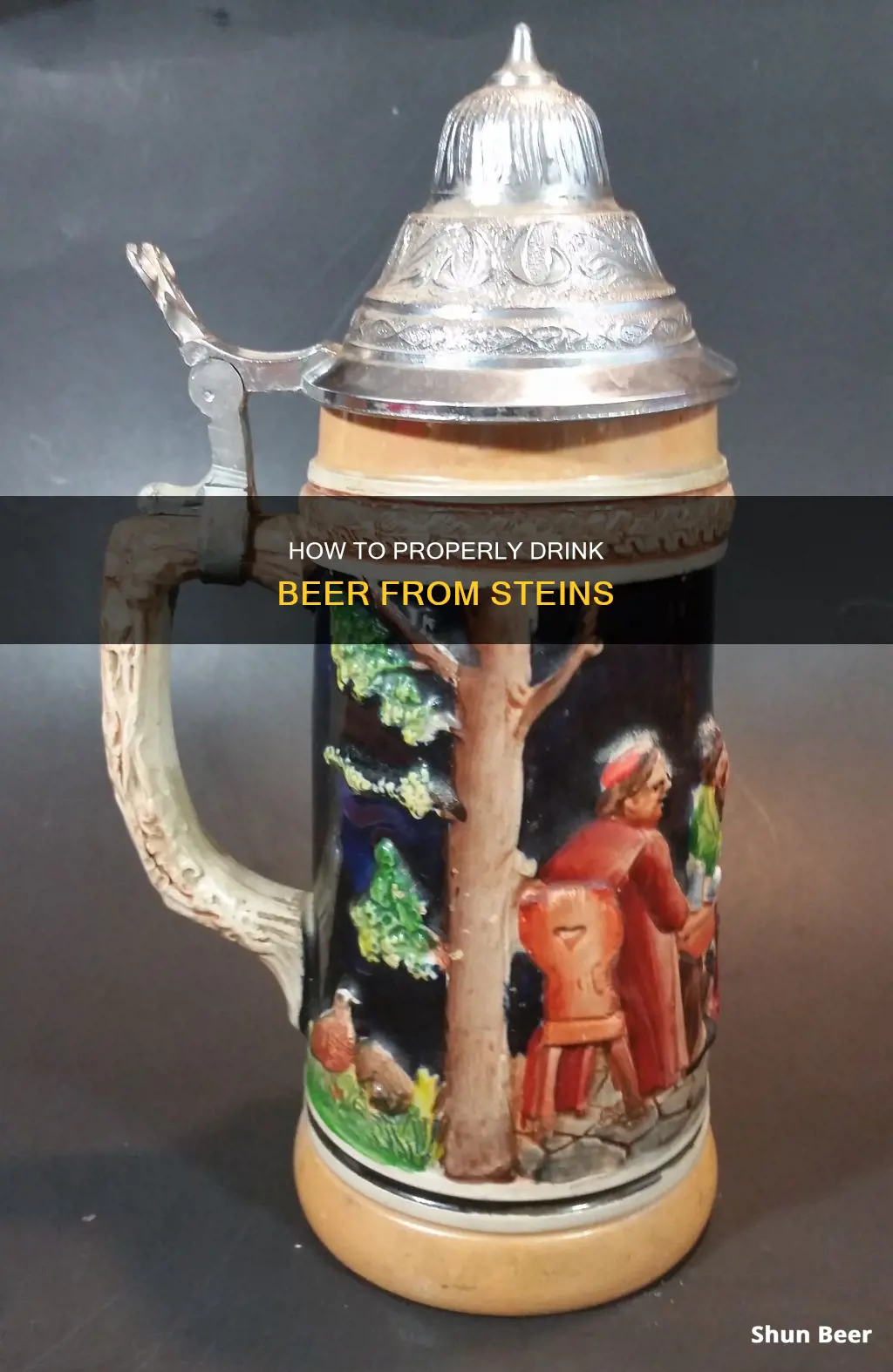
Beer steins are traditional beer mugs that originated in Germany. They are made from a variety of materials, including stoneware, pewter, porcelain, silver, wood, crystal, and glass. The word stein is derived from the German word for stone, and the history of the beer stein dates back to the late 1500s in Germany. Beer steins are known for their hinged lids, which were originally implemented to protect drinks from insects and leaves, especially during the Black Plague. Over the years, they have become a symbol of Bavarian culture and coziness, especially during Oktoberfest. Beer steins are often decorated with ornaments, paintings, or coats of arms, making them collectible items and a popular choice for beer enthusiasts.
| Characteristics | Values |
|---|---|
| History | Beer steins date back to the late 1500s in Germany. |
| Symbolism | Beer steins are a symbol of Bavarian coziness and were once a status symbol. |
| Function | Beer steins are used to hold and serve beer, with some believing they enhance the flavour. |
| Material | Beer steins can be made from stoneware, pewter, porcelain, silver, wood, crystal glass, or earthenware. |
| Lid | Beer steins often have a hinged lid with a thumb lever to keep insects out and the beer cool. |
| Durability | Beer steins are durable and resistant to regular wear and tear. |
| Collectibles | Beer steins are often collectible items, with some being limited editions or souvenirs. |
| Size | Beer steins typically hold a half litre or a full litre of beer. |
What You'll Learn

Beer steins are a status symbol
Beer steins, or simply "steins", are traditional beer mugs made out of stoneware, or ornamental beer mugs sold as souvenirs or collectibles. They are often decorated with allusions to Germany and may be made out of stoneware, pewter, porcelain, silver, wood, or crystal glass. They usually come in sizes of half a litre or a full litre.
The history of the beer stein dates back to the late 1500s in Germany. At the time, they were a vessel for drinking beer, displaying status, and protecting against the Bubonic Plague. Over the centuries, they have become a staple at bars and pubs around the world. Beer steins are still a status symbol, as they were in the early days of their evolution. Back then, stoneware mugs were expensive, and people who owned them would pay a little extra to have an artist create a beautiful, custom work of art on their stein. The community recognised stein owners as having status because of their vessel.
Nowadays, beer aficionados still appreciate the luxury associated with the beer stein. They are made from a variety of fine materials and feel weighty and substantial in your hand. Sipping a delicious brew from a beer stein feels more indulgent and special than drinking from a regular glass. Establishments that offer the option of a beer stein are typically those that value both the presentation of their beer and offering their patrons an experience that enhances the flavour of the brew.
Beer and Steroids: A Dangerous Mix?
You may want to see also

They are durable
Beer steins are durable, and their longevity is one of the reasons they are so collectible. They are mostly made of thick glass or ceramic material, which makes them incredibly durable and resistant to regular wear and tear. This means you can drink your beer without worrying about your mug shattering or chipping easily. Most stoneware beer steins are dishwasher-safe, making them simple to clean and preserve.
The durability of beer steins is also why they are the preferred vessel for enjoying a nice cold brew. Beer steins are constructed of materials that are built to last and can stand up to daily use. They are sturdy and offer unique features like handles and texturing that make for an easier-to-grip beer mug, reducing the chances of drops or spills.
The history of the beer stein dates back to the late 1500s in Germany, and they have been made from a variety of materials, including stoneware, pewter, porcelain, silver, wood, earthenware, and crystal. Over the centuries, the designs and materials have evolved, but the core function of durability has remained.
The durability of beer steins also allows for their use as a status symbol. In the early days, stoneware mugs were expensive, and those who owned them would spend extra to have an artist create a beautiful, custom work of art on their stein. The community recognised these individuals as having status. Even today, beer steins are appreciated for the luxury and indulgence they convey.
Non-Alcoholic Beer: Safe, Sensible, and Socially Acceptable?
You may want to see also

Steins can be personalised
Beer steins can be personalised with a variety of engravings, etchings, and customisations. Whether you're celebrating a wedding, Father's Day, or simply your love of German beer, a personalised stein is a great way to mark the occasion. You can add names, dates, logos, or any other text to create a unique and memorable gift.
Many steins are made from glass, crystal, or ceramic, which can be engraved or etched with custom designs. You can also add a personal touch to the lids of beer steins, which are usually made from pewter and feature a thumb lever. The lids can be decorated with handcrafted motifs, engravings, or even pewter figures.
Personalised beer steins are a great way to commemorate special occasions and create lasting souvenirs. They can be given as gifts for groomsmen, added to a collection, or used to enhance the drinking experience by making it more indulgent and special.
You can also personalise beer steins with photos or pictures, making them ideal for preserving memories of family reunions, corporate picnics, or local festivals. Whether you're toasting at a wedding or simply enjoying a beer with friends, a personalised beer stein adds a unique and festive touch to any occasion.
Beer and Cholesterol: Drinking Before a Test
You may want to see also

They might improve the taste of beer
Beer steins are drinking vessels that have been used for centuries, dating back to medieval Germany. They are often made of materials such as stoneware, pewter, porcelain, silver, wood, crystal glass, or earthenware. While the use of beer steins might be largely cultural and traditional, some believe that drinking beer from a stein can enhance its taste. Here are some reasons why beer might taste better when consumed from a stein:
Temperature Maintenance
Beer steins are typically made of thick glass or ceramic materials, which provide insulation and help keep the beer cooler for longer. This is especially advantageous during warm weather when maintaining the cool temperature of the beer is crucial. By placing the stein in the fridge before serving, the insulating properties are further enhanced, resulting in a longer-lasting chilled beer.
Enhanced Fragrance and Taste
The shape of a beer stein, with its wider mouth, allows for a greater head on the beer. This increased surface area facilitates the release of the beverage's fragrance and enhances its taste. The froth and bubbles are reduced, providing a smoother drinking experience.
Porous Nature of the Stein
Some enthusiasts believe that the porous nature of the stein's material, particularly stoneware, enables it to retain flavour over time. The beer may absorb subtle flavours from the stein, creating a richer and more complex brew.
Optimal Beer Temperature
The thick stoneware or ceramic construction of beer steins also contributes to maintaining the optimal temperature for beer consumption. The insulating properties of these materials help keep the beer at the ideal temperature for a more prolonged period, ensuring that each sip is as refreshing as the first.
Personalised Experience
Beer steins are often personalised or customised, featuring engravings, paintings, or ornaments. This personal touch adds to the drinking experience, making it more intimate and enjoyable. The act of drinking from a unique and customised vessel can heighten the sensory experience and create a sense of indulgence.
Historical Significance
Drinking from a beer stein is more than just a practical choice; it is a nod to the rich cultural heritage of Germany. The tradition of using steins dates back to the late 1500s in Germany, where they were initially used to protect against the bubonic plague. By drinking from a stein, one connects with this historical context, adding a layer of depth and tradition to the drinking experience.
Beer and Breastfeeding: Is It Safe?
You may want to see also

Steins are collectible items
Beer steins are highly collectible items, with some steins valued at over $100,000. The largest free online database of collectible and antique beer steins, MySteinCollection.com, has images and information on 17,122 steins from private collections and producer's catalogs.
Beer stein collectors tend to fall into two categories: those who collect specific types of steins, such as those from a particular country or era, and those who collect steins with specific themes, like humorous designs. The majority of collectors display their steins in their homes.
The most collectible beer steins are those with traditional designs, such as:
- Brewery emblems
- Bavarian motifs
- Colourful official annual Oktoberfest designs
- Folk tales
- Patriotic German scenes
- Regimental steins
- Glass-blown steins
The most sought-after manufacturers include Mettlach, Royal Vienna, and Capo-di-Monte.
The best beer steins are made from a variety of fine materials like porcelain, stoneware, silver, pewter, or wood, and they are weighty and durable. They are often ornately decorated with ornaments, paintings, or coats of arms, and some have hinged lids.
Beer and Kidney Infections: Is It Safe to Drink?
You may want to see also
Frequently asked questions
Yes, beer steins are meant to be used for drinking beer. They are traditional German beer mugs that date back to the late 1500s.
Beer steins are typically made of materials like porcelain, stoneware, silver, pewter, wood, or crystal glass.
Drinking beer from a stein provides a traditional experience and can keep the beer cooler for longer. Beer steins are also durable and can make the beer taste better by providing a greater head, which aids in the release of fragrance and taste.







